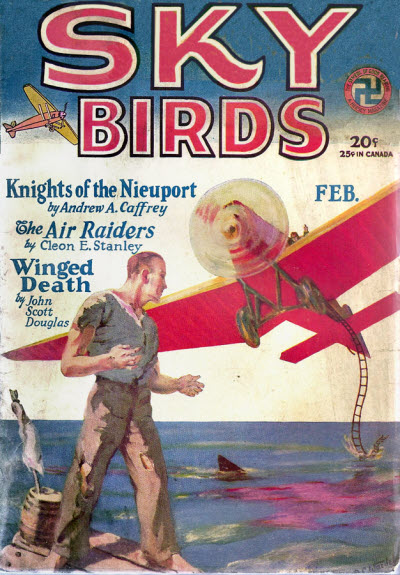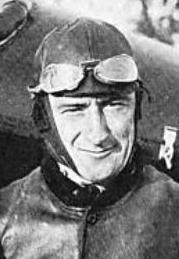“Knights of the Nieuport” by Andrew A. Caffrey
THIS week we have  another story from one of the new flight of authors on the site this year—Andrew A. Caffrey. Caffrey, who was in the American Air Service in France during The Great War and worked for the air mail service upon his return, was a prolific author of aviation and adventure stories for both the pulps and slicks from the 1920’s through 1950. For the second issue of Sky Birds, Caffrey tells the story of Lieutenant Mike Harris—a.k.a. “Coupe Mike” due to his proclivity to overuse the coupe button during his training—fresh up from Issoudon after extensive training.
another story from one of the new flight of authors on the site this year—Andrew A. Caffrey. Caffrey, who was in the American Air Service in France during The Great War and worked for the air mail service upon his return, was a prolific author of aviation and adventure stories for both the pulps and slicks from the 1920’s through 1950. For the second issue of Sky Birds, Caffrey tells the story of Lieutenant Mike Harris—a.k.a. “Coupe Mike” due to his proclivity to overuse the coupe button during his training—fresh up from Issoudon after extensive training.
Caffrey himself gives a vague bit of the background for the tale while praising Hersey on his great line of aviation titles in a letter in the Ailerons column from the same issue:

From the February 1929 issue of Sky Birds:
“Coupe Mike,” they called him. He was named a Lieutenant by the War Department, and Michael by an adoring mother. However, Fate dubbed him a Black Cat for luck until Fate changed his mind and so furnished the material for a bang-up air novelette.
- Download “Knights of the Nieuport” (February 1929, Sky Birds)
As a bonus, here’s a brief autobiography of sorts by Andrew that ran in the April 1928 New McClures Magazine:
 MY LONG-LOAFING experience was started back in Lawrence, Massachusetts, on the coldest March the eleventh that 1891 knew. That makes me twenty-one by actual count.
MY LONG-LOAFING experience was started back in Lawrence, Massachusetts, on the coldest March the eleventh that 1891 knew. That makes me twenty-one by actual count.
Early in May, 1917, I talked the War over with a recruiting sergeant in San Francisco and he promised that it would last long enough. Well, before I was in that uniform for one full lay I knew that the War had lasted too long. And it was more than three years before I gazed at a bird in a mirror of a New York automat and wondered why he looked back at me, and like me. It was so long since I had seen me in civvies that I was startled, as someone has said, to stillness. Yet, for the first time in a long while i liked me.
After the War I was with air mail in San Francisco. Later I went as a civilian employee to McCook Field, Dayton. There I worked with the cross-country section and flew much over the East. When Clover Field, Santa Monica, came into existence I came here as Chief Mechanic. Out of Clover Field I flew on much long-distance work; coast to coast and north and south. We were trying to prove that aviation had arrived. It hadn’t and it hasn’t: and I, for one, know that there’ll be lots of good flying ten years from now. And wanting to be in on some of the good flying, I gave the thing up till such time as some great skill unfolds the future of air. Over periods of years at a time we followers of air lose track of old pals. But sooner or later we always find them, and in the same place—in the crashed and killed news. As long as that is true flying has not arrived. The game today is just as dangerous as it was when the Wrights hopped off at kitty Hawk. That’s why the one living Wright, Curtiss, Martin and the old men of the air stay on the ground. They know, and better than anybody else realize, that the patron saint of aviation is the Fool Killer.
Fact is, I am one of an ex-army of broken men. And I tell you what: it’s been a hard quiet war for a lot of us boys ever since a certain long lank kid clapped a cool blue eye to a periscope and found Paris. . . Find Paris! Say, isn’t it just possible that a lot of us should get off the controls and let somebody fly who can fly? . . . But it’s tough to be running around with clipped wings and have no willing ears to tell it to. Lindy has done a lot for aviation, but look what he’s done to the rest of us!
Well, I’m sure sorry for the rest of the boys, but just so long as McClure’s will let me fly now and then I’ll try to keep a stiff upper lip and the rest of the fixings.

* The above picture of Andrew A. Caffrey is cropped from a picture that accompanied Caffrey’s article “West is East (Or Delivering the General’s Nickel-Plated Dog Kennel)” that appeared in the pages of the December 1923 issue of U.S. Air Service.




